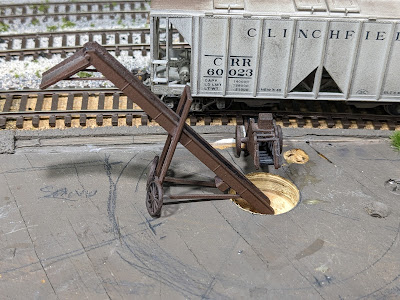The Track Dept. has undertaken a couple of projects recently, to shore up the Railway's continuing ability to haul coal at volume.
TRUSS BRIDGE UPGRADE
Now you probably know the term "kit" in this case is an ironic wink/nod to a thick pile of dissociated plastic shapes, and a stick-figure diagram of miter angles. I was able to get the deck in place fairly quickly, but the truss took me another eight elapsed months to finish. (Naturally within minutes of its completion, Walthers introduced a beefy truss bridge of similar dimension that takes only an evening or two to assemble. But I'm not bitter... )
Anyway I was pleased with the result, but it had two major drawbacks:
- It's a spindly iron design from the turn of the century (the last century), more suited to a granger branch than a coal-hauler's heavy mainline. One system of diagonals is just a pair of pin-connected strap bars... And the opposing diagonals are even weenier, being just a pair of tie-rods.
- In the kit, the tie-rods are strung using plastic monofilament, which I over-tightened in a me-like fashion** to such an extent that they were actually deforming the truss into a bow. So I cut them, allowing the truss to relax and spring back to its preferred trapezoid shape, which was much more pleasing to the eye***. But now there were random disconnected tie-rods rattling around, if you cared to notice.
Friends claim they never noticed the weedy floating tie-rods, but then "they might be jivin' ya too".
Here's Tom's gorgeous example -- click here for the November 2011 issue of MRH.
Having already spent 1% of my total lifespan on the original kit, however, I was loath to go to such an extent on an upgrade. So I opted for the SNR "zinc standard", which is just sufficient effort to move the needle from "Silly" to "Good Enough For Operations".
To replace the tie-rods, I used the lighter of the two CV girders -- the same ones the kit uses as verticals. They don't provide quite the added beef as Tom's approach did, but importantly, they could be tucked through the latticework and into the box girders that form the top and bottom chords, without all that exacting surgery. I re-used the strap bars, and passed them through the centers of these new diagonals.
I finished it off with a coat of flat black (would you believe I'd never painted the thing), and a light rust wash with acrylics. The result is way 80/20 -- not a contest winner, but looks substantially more stout than the original -- far less likely to collapse into the James under the weight of a giant Lima Berk.
IMPROVED CLEARANCE AT WICKED RIVER
Hey speaking of Lima Berks, you may recall that the town of Segway is so named because it's where the Virginia Piedmont segués into the Blue Ridge. It was intended as a division point, where the high-stepping 69"-drivered Berkshires (or, Kanawhas) are taken off of westbound freights, in favor of mule-legged Mallets which can take their sweet time grinding up the ruling grade.
As it's played out, though, Segway doesn't really work as a division point.
- There's just not enough room to make Yaeger Yard big enough for such a function. And,
- The engine terminal is tight even by SNR standards. Shoehorning Mallets and Berks around the streetcar curves and onto the Heljan turntable, with scale inches to spare (usually), is a headache for the yardman, who is quite busy enough just keeping trains moving.
FOOTNOTES
** I have a lifelong fear of being that wormy guy who doesn't tighten bolts adequately. So I have a tendency to overcompensate -- to keep cinching things down until I either strip the threads, or bend the work. A car friend once made me a set of diagonal struts for the nose of my 1962 Cadillac that would help quell the convertible "cowl flex", as he'd done with his own '62. However, when I installed them, I cranked them down so tight I actually deformed the 3-piece front bumper into a crescent. Brilliant.
*** What's really interesting about this bridge is that, even with actual steel reinforcement inside the deck stringers, the truss actually does provide useful support, rather than just looking pretty. With the truss superstructure removed, a locomotive will materially flex and sag the deck, a solid 1/8" or more at mid-span. Whereas with it clipped in place under the cross-bearers, even with the old tie-rods cut, the entire span stays rigid. This is not only cool, it is a big help in encouraging trains to stay on the rails. More than "Life imitates art", I'd say this is something like "Life continues to happen, even in art".
**** OK, nerd time! By replacing the weakest diagonals -- the tie-rods -- with girders, and keeping the lighter strap bars in the same orientation, technically what I created was a Howe truss. In a Howe design, the heavier diagonals lean toward the centerline, and are in compression, with the verticals in tension. Whereas with the Pratt, the opposite is true: the heavier diagonals fall away from the centerline and are in tension, with the vertical members being the ones in compression..
This explains the lacey look of the stock CV Pratt truss: the thing is being held aloft entirely by the tension through pin-connected iron strap bars. It also explains why one ought not run 400-ton Berkshires across it! I didn't become a civil engineer because for starters I couldn't stomach the second semester of calculus (also see note on over-tightening, above**), but it still is fascinating as heck.- Bridge Types -- a great one-page overview of the various designs, if you've ever wondered, done by the Iowa D.O.T. of all people.
- Practical Engineering -- one of my favorite YouTube guys, Grady Hillhouse, distilling civil engineering concepts into short digestible bites for the pedestrian. With dry humor added.

















































